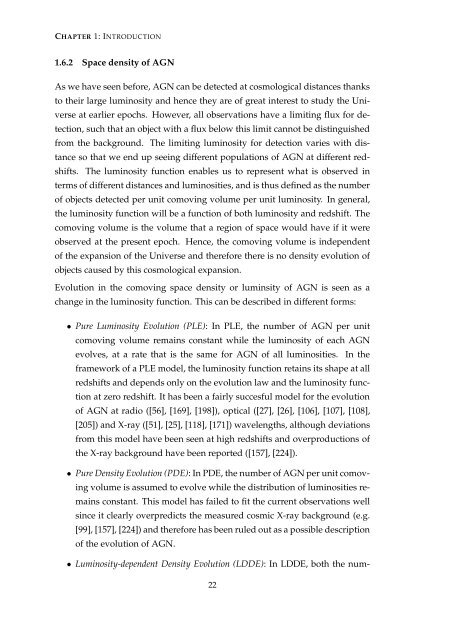pdf - SRON
pdf - SRON
pdf - SRON
You also want an ePaper? Increase the reach of your titles
YUMPU automatically turns print PDFs into web optimized ePapers that Google loves.
CHAPTER 1: INTRODUCTION<br />
1.6.2 Space density of AGN<br />
As we have seen before, AGN can be detected at cosmological distances thanks<br />
to their large luminosity and hence they are of great interest to study the Universe<br />
at earlier epochs. However, all observations have a limiting flux for detection,<br />
such that an object with a flux below this limit cannot be distinguished<br />
from the background. The limiting luminosity for detection varies with distance<br />
so that we end up seeing different populations of AGN at different redshifts.<br />
The luminosity function enables us to represent what is observed in<br />
terms of different distances and luminosities, and is thus defined as the number<br />
of objects detected per unit comoving volume per unit luminosity. In general,<br />
the luminosity function will be a function of both luminosity and redshift. The<br />
comoving volume is the volume that a region of space would have if it were<br />
observed at the present epoch. Hence, the comoving volume is independent<br />
of the expansion of the Universe and therefore there is no density evolution of<br />
objects caused by this cosmological expansion.<br />
Evolution in the comoving space density or luminsity of AGN is seen as a<br />
change in the luminosity function. This can be described in different forms:<br />
• Pure Luminosity Evolution (PLE): In PLE, the number of AGN per unit<br />
comoving volume remains constant while the luminosity of each AGN<br />
evolves, at a rate that is the same for AGN of all luminosities. In the<br />
framework of a PLE model, the luminosity function retains its shape at all<br />
redshifts and depends only on the evolution law and the luminosity function<br />
at zero redshift. It has been a fairly succesful model for the evolution<br />
of AGN at radio ([56], [169], [198]), optical ([27], [26], [106], [107], [108],<br />
[205]) and X-ray ([51], [25], [118], [171]) wavelengths, although deviations<br />
from this model have been seen at high redshifts and overproductions of<br />
the X-ray background have been reported ([157], [224]).<br />
• Pure Density Evolution (PDE): In PDE, the number of AGN per unit comoving<br />
volume is assumed to evolve while the distribution of luminosities remains<br />
constant. This model has failed to fit the current observations well<br />
since it clearly overpredicts the measured cosmic X-ray background (e.g.<br />
[99], [157], [224]) and therefore has been ruled out as a possible description<br />
of the evolution of AGN.<br />
• Luminosity-dependent Density Evolution (LDDE): In LDDE, both the num-<br />
22
















